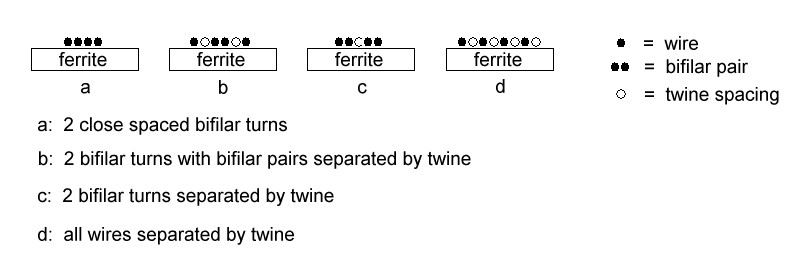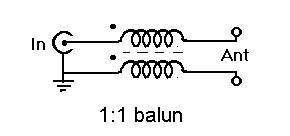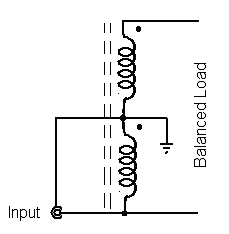Note: This twine is polypropylene and is the preferred choice since it will not absorb water.
Winding Method

1:1 Rod Balun

Ferrite Rod: R-61-037-300
Construction:
Start by winding a layer of ptfe tape on the rod
Cut two 500mm lengths of 1.25mm enamelled copper wire for a bifilar winding.
Starting at the centre of the rod, close wind half the length of the wires towards one end. Repeat for the other half. 12 bifilar turns (24 wires) should now be centred on the rod, with sufficient end lengths for terminations. If the lowest operating frequency is 3.5MHz then 10 turns is sufficient.
Cut the spacing twine into 500mm lengths and insert between the wires as required by tightly pulling the cord between the turns. This makes a secure finished winding. Start at the centre of the winding and work towards each end.
For a 50 ohm balun put spacing twine between the bifilar turns (winding method c).
For a 75 ohm balun put spacing twine between all wires (winding method d).
Waterproof, terminate and house the finished balun as required.
See test results for the rod balun.
1:1 Toroid Balun

Ferrite Toroid: FT-140-61.
Use the same winding method and materials as in the rod balun above.
Construction:
Spread the 12 bifilar turns evenly around the core. This leaves space between the 12 turns (24 wires).
If the lowest operating frequency is 3.5MHz then 10 turns is sufficient.
For a 50 ohm balun the bifilar pairs are close spaced (winding method a).
For a 75 ohm balun put spacing twine between the bifilar pair(winding method b).
See test results for these toroid baluns.
4:1 Toroid Balun

Ferrite Toroid: FT-140-61.
Use the same winding method and materials as in the rod balun above.
Construction:
Spread the 12 bifilar turns evenly around the core. This leaves space between the 12 turns (24 wires).
If the lowest operating frequency is 3.5MHz then 10 turns is sufficient.
For the 50:200 ohm balun the bifilar pairs are close spaced (winding method a).
For the 75:300 ohm balun put spacing twine between the bifilar pair (winding method b).
See test results for these toroid baluns.
20/11/04
homepage